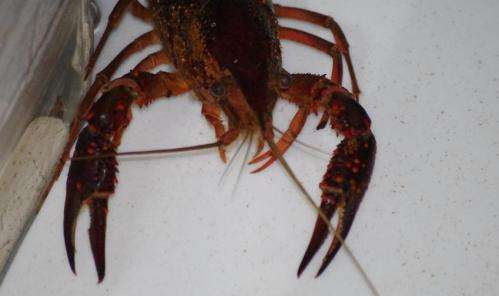June 13, 2014 report
Study shows crayfish exhibit anxiety-like behavior when stressed

(Phys.org) —A team of researchers working in France has found that when stressed, crayfish tend to exhibit anxiety-like behavior. In their paper published in the journal Science, the team describes how they conducted experiments involving crayfish behavior under stressful conditions and found that in addition to changes in behavior, the crustaceans also had elevated levels of a neurotransmitter also found in stressed humans.
Stress and anxiety are common problems in modern life as people try to fulfill expectations that arise from their jobs, family life and friends. Prior research has shown that stress is hard on people, both mentally and physically. For that reason, scientists have been searching for many years for ways to alleviate the stress that people feel—they've come up with many solutions, from advocating exercise to administering pharmaceuticals. None have been found to be the ultimate cure, however, so the search continues. In this new effort, the researchers in France studied anxiety behavior due to stress in crayfish to gain a new perspective on the condition and perhaps ways to treat it.
To find out how crayfish respond to stress, the researchers subjected several of them to mild electric shocks then placed them into a specially designed tank of water—it was shaped like a cross, with two wings well lit, and two left in the dark. The researchers found that when the stressed crayfish were placed into the tank, they tended to avoid the well lit wings—a protective sort of behavior. Unstressed crayfish placed in the tank were tentative but did eventually explore the well-lit parts of the tank as they searched for food.
In another part of the experiment, the researchers examined the stressed crayfish and found they had elevated levels of serotonin, the same neurotransmitter that has been found to be elevated in stressed humans. The team found that they could cause the same types of protective behavior in the crayfish just by injecting them with serotonin. They also found that they could calm the crayfish by injecting them with chlordiazepoxide, a drug used to treat anxiety in humans—afterwards the stressed subjects ventured into the well-lit parts of the tanks in much the same ways as the unstressed crayfish.
The researchers note that their findings do not indicate that crayfish feel stress or anxiety in the same ways as we do, but instead suggest that the mechanism behind both is clearly similar, which hints at a shared evolutionary origin.
More information: Science 13 June 2014: Vol. 344 no. 6189 pp. 1293-1297 DOI: 10.1126/science.1248811
Journal information: Science
© 2014 Phys.org


















